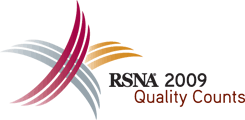
Abstract Archives of the RSNA, 2009
SSK17-03
Bare Spot of the Glenoid in Children: Incidence and MRI Features
Scientific Papers
Presented on December 2, 2009
Presented as part of SSK17: Pediatrics (Musculoskeletal)
Hee Kyung Kim MD, Presenter: Nothing to Disclose
Kathleen Helme Emery MD, Abstract Co-Author: Nothing to Disclose
The bare spot of the glenoid is an area of focal articular cartilage thinning or loss at the central portion of the glenoid and has been described as a normal variant in adults. The bare spot has been used on arthroscopy as a landmark to assess bony loss of the inferior glenoid for the orthopedic surgeon to determine stability of the glenohumeral joint. There are some papers dealing with the measurements of the distance of the bare spot from the anterior, posterior and inferior aspect of the glenoid on CT scan. However, there is no reported study of MR assessment, although MRI is the best imaging modality for assessing articular cartilage. A prior cadaveric study demonstrated a relatively high incidence of this glenoid bare spot in up to 80 % of the adult population. We have noted this finding on some clinical shoulder MRI studies of pediatric patients, but there is no published study about the incidence in the pediatric population. The purpose of this study is to evaluate the MRI findings and incidence of the glenoid bare spot in children.
All shoulder MR images from 1997 to 2009 including shoulder MR arthrograms and routine shoulder MR without contrast injection were reviewed. Patients were divided into two age groups: group1: age ranges 0 – 10 years, group 2: 11 -20 years. A total of 398 shoulder MR studies were reviewed (group 1: 120 cases, group 2: 278 cases).
Among 398 MR images, 9 cases of bare spot were identified (2.26%). All cases were seen in group 2 and no case was seen in group 1. All nine cases showed a well marginated central thing of the articular cartilage of the glenoid containing hyperintense joint fluid or contrast. One case showed an abnormal dark signal within the bare spot on MR, which was confirmed as air on CT scan.
The bare spot is seen in pediatric patients. The absence of this finding in children under age 10 and the low incidence in the second decade of life as compared to the adult population support the proposed acquired nature of this normal variant. Familiarity with this normal finding is important for the radiologist so as not to misinterpret it as a pathologic condition such as an osteocartilaginous defect.
Familiarity with this normal finding is important for the radiologist so as not to misinterpret it as a pathologic condition such as an osteocartilaginous defect.
Kim, H,
Emery, K,
Bare Spot of the Glenoid in Children: Incidence and MRI Features. Radiological Society of North America 2009 Scientific Assembly and Annual Meeting, November 29 - December 4, 2009 ,Chicago IL.
http://archive.rsna.org/2009/8011184.html

